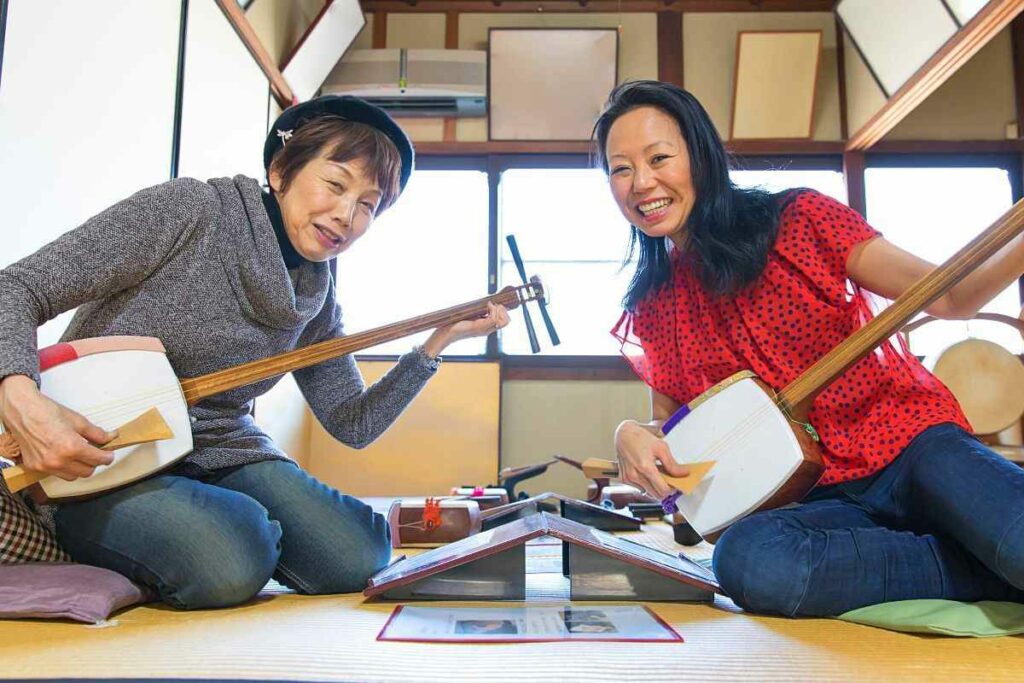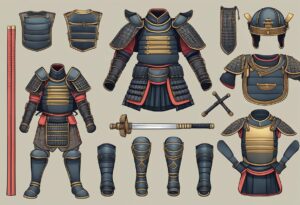Musical instruments have been in used for around forty-thousand years.
Along with the humans who make them, they have progressed and developed, evolving into a plethora of varying types.

One category of them which stands out, is string instruments and in Japan, there is an array of them which would be almost unrecognisable in the western world.
Here, we will present 9 uniquely Japanese string instruments.
Table of Contents
Are Japanese String Instruments Different?
When you think of string instruments, your mind will usually lean towards guitars, violins, and the Banjo.
Travel East, however, and you will find instruments with some similarities, but that appear alien in comparison.
From the guitar-like Biwa to the violin-like Kokyu, the Japanese have many fascinating string instruments:
- Zithers – consisting of many strings across a flat body.
- Harps – bow-like with angled strings across.
- Lutes – similar to guitars.
- Bowed – like the Cello or Violin.
#9 Biwa
A popular instrument in Japan, the Biwa is a four or five-string instrument similar to the shape of a guitar but with some striking differences.
Its basic design is the same, but the shape is more oval (lute-like) and as with the electric guitar, it isn’t hollowed out.
It is usually made from a single piece of wood. Frets are raised high off the neck, and it is based on the design of the Chinese Pipa.
It is, on the other hand, played differently (with a huge triangular plectrum known as a Baichi) and sounds nothing like it. This instrument was often used at imperial court, providing music alongside tales of Folklore and is now quite rare.
Interesting Fact: There is a lake in Japan that is shaped like a Biwa and therefore takes its name from it: Lake Biwako.
#8 Shamisen
This word translates to ‘three strings’ and is an instrument similar to both the Biwa and Sanshin in the sense that it consists of the same fundamental structure.
Purportedly making its way into Japanese culture during the Edo period (1603-1868), its body was once veneered with animal skin like a drum but is now constructed with plastic.
Its body is also a square shape, used to make a percussive sound against the strings and its neck has no frets.
This one also uses a baichi, but it has a unique sound thanks to the placement of the strings. Positioned over a brass nut, one string creates a buzzing noise which makes the Shamisen stand out in the crowd.
#7 Sanshin
Similar to the Shamisen, this also translates literally as ‘three strings’ and it is like a Shamisen in many ways.
Covered in the skin of a python, it too creates a percussive sound alongside the strings.
Unlike other instruments though, it is played using a small hollow tool that fits to the index finger and is used to pick the strings sharply.
At the centre of folk music in Okinawa, the Sanshin sounds like a Banjo and is associated with Deities in Ryukyu culture.
#6 Tonkori
With a shape not unlike that of a Cricket bat, this unusual Japanese instrument is another without a fretboard and the strings are played without being pressed.
Consisting of a minimum of 5 strings – sometimes more – it is native to Hokkaido and other northern areas of Japan.
Uniquely, it tuned in what is known as a re-entrant tuning: whereby the strings are not tuned in ascending or descending order but rather in an alternated one. This creates a very individual sound and likely makes the Tonkori the most unique of all.
#5 Kokyu
As a violin is to a guitar, the Kokyu is to a Shamisen.
A smaller version of this square string instrument, the Kokyu is played with a bow of horsehair much like a violin.
More recently, a fourth string is added to extend the range of sound, as well. Thought to be derived from the Chinese Huqin, the Kokyu is believed to have first emerged in Okinawa as the Kucho.
This original version had a round body and some still exist in Okinawa today. Otherwise, it is made with a square body and is used in modern Japanese Jazz.
#4 Koto
Although most governments in the world do not recognise national instruments, Japan is one exception to this.
The Koto is Japan’s national instrument not unlike the Chinese Guzheng. Another instrument used in the Japanese Imperial Court, the Koto dates back to the Nara period (710-794).
Generally, they have 13 strings producing a wide range of notes. Some, however, have 17 strings (Junanagen) or more. As with a guitar, there are variations of the Koto, such as the bass Koto with over 20 strings.
Interesting note: The Koto is traditionally used in romantic music due to it sounding similar to the Harp.
#3 Taishogoto
Created in the early 20th century, this Japanese string instrument emerged in the Taisho period.
Almost a pun, its name is a compounding of ‘Taisho’ and ‘Koto’. A variation of the Koto, this unique instrument was inspired by none other than the Typewriter…
Keys very reminiscent of an old typewriter, are used to put pressure on the strings while they are simultaneously strummed.
Producing notes in the familiar 12-note scale, the Taishogoto is considered simple to learn and the keys make it much easier to play than most string instruments.
#2 Ichigenkin
An ancient instrument, this monochord has but one string attached to a curved piece of Kiri wood.
It is played with a similar hollow pick to that used for the Sanshin, but another is placed on the middle finger of the opposite hand.
The player uses this, something like a guitar slide, to vary the pitch. Both tools are referred to as ‘rokan’. Believed to be a derivative of the Chinese Guqin, its name means ‘one-string zither’.
#1 Yakumogoto
Close in design to the Ichigenkin, this has an additional string, and its name translates to ‘eight cloud zither’.
This two-string version was invented in 1820 and has grown great prominence in Shintoism. Other variations have since emerged.
In the 19th century, a three-string version was made known as the Sangenkin; a type with a open back and a slightly different sound.
Frequently Asked Questions
What is special about a koto?
What is ‘Kokyu’ in English?
What is the difference between the Pipa and Biwa?
What is traditional Japanese music called?
What are Japanese guitars called?
Final thoughts
Japan has one of the most fascinating cultures on planet Earth, and this is reflected greatly in the uniqueness, variety, and beauty of its musical instruments.
Although naturally similar to western instruments, in design, Japanese string instruments are very different in many ways. Exploring culture is one thing, but doing so through music can be an enriching experience, particularly in the historic culture of Japan.
- 12 Things Tourists Should NEVER Say in Japan
- Kissing Robot: Exploring the Popularity of the Chinese Kissing App
- Unlocking the Secret Dating Rituals Only Locals Know in Japan
- Samurai Armor: Ancient Protection for Japan’s Elite Warriors
- 10 Amazing Facts About Schools in Japan: Unique Traditions and Educational Practices
- Where can you see snow monkeys in Japan: Best locations and viewing tips









